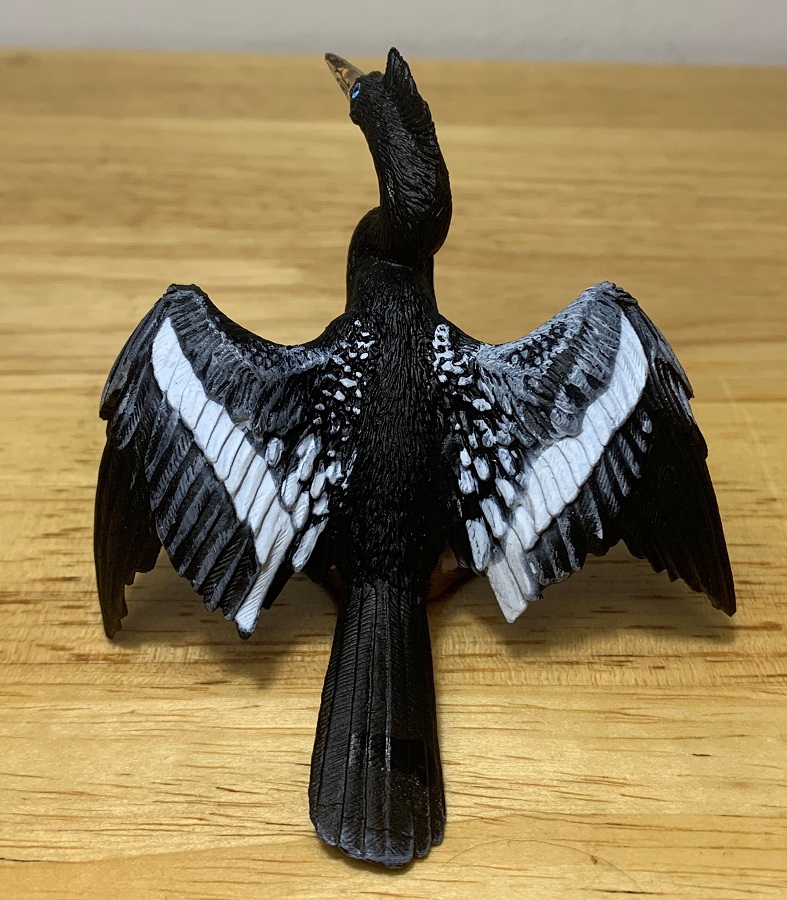This past week I took a trip to Bombay Hook National Wildlife Refuge in Delaware, a vast tidal salt marsh that for this summer has provided a home to four wayward roseate spoonbills. Seeing these birds got me wanting to review a spoonbill, but alas, I don’t have one. Instead, I’ll settle on another water bird from the American deep south, the anhinga (Anhinga anhinga).

The anhinga occurs from the southeast American coast, south through Central America, and down into a large swath of South America. The anhinga occasionally wanders elsewhere including where I live so I might get to see one of them eventually, without having to travel to them. The anhinga goes by many names, including water turkey, darter, and snakebird. That last name is derived from the bird’s habit of swimming underwater with only the head and neck sticking out, looking something like a serpent or the Loch Ness monster. Indeed, the name anhinga itself comes from a Brazilian Tupi word that means “snake” or “devil” bird.

The Safari anhinga is, to the best of my knowledge, the only toy anhinga available. It was released in 2014 and remains in production. It’s a logical choice for Safari Ltd., based in Florida where the species is common. The Safari anhinga stands 3.3” (8.3 cm) tall and measures 3” (7.6 cm) wide.

I must confess that I absolutely hate trying to figure out the scale of bird figures. Their bent necks or wings usually make precision measurements difficult. The actual anhinga measures about 35” (88.9 cm) in length with a 3.7’ (1.12 meters) wingspan. Considering the bend in the neck while scaling the figure, I put it at about 1/7 scale.

Anhinga prefer to live in shallow, slow moving freshwater habitats, such as swamps and marshes. Anhinga don’t have waterproof feathers and can become waterlogged, this along with their dense bones allows them to stealthily hunt fish and other aquatic animals underwater without much effort required to stay down. Anhinga must dry themselves out before they can fly so seeing them bask with their wings outstretched in the sun is a common sight where they occur. The toy is presented in this drying out posture.

The Safari anhinga represents a male, with its black plumage. Female anhinga have a brown head, neck, and breast. The figure is also painted with white streaks and spots on the wings, a black and orange bill, orange webbed feet, and blue eyes. Original releases of the figure lacked the white streaks and spots, with the bird painted entirely black. The figure was updated to include the white in 2016.

Like other figures in the Wings of the World series the anhinga is meticulously sculpted, with the feathers on the wings and tail exceptionally well executed. A small crest is sculpted on the top of the head which in the actual bird can be relaxed and laid flat. Smaller feathers are etched into the sculpt along the rest of its body.

Anhinga closely resemble cormorants and belong to the Suliformes order, along with cormorants, shags, boobies, frigatebirds, and gannets. Including the two sub-species of the American anhinga there are four species in the Anhinga genus. They range around the tropical portions of the world.
The Safari anhinga is a splendid little toy of a fascinating species. My only complaint about it is that it does look a bit cartoonish in the face, but I’m not sure what would fix that. I think it has to do with the large blue eyes and the erect crest. The bill is perhaps a bit too short and blunt, but this is intended to be a kids toy as much as it is a collectable, the bill is still surprisingly pointy. The Safari anhinga usually retails for $3.99 but is currently on sale on Safari’s website for $1.99. If you don’t already have it, now’s the time to get it!
Disclaimer: links to Ebay and Amazon on the AnimalToyBlog are affiliate links, so we make a small commission if you use them. Thanks for supporting us!




Wonderful! I have seen anhingas when I have visited Florida.
And yes, calculating scale for most birds is a pain. Some (like ostrich, emu, etc.) you can probably use height. But most birds are measured from dead specimens stretched out, from beak tip to tail, so one must account for things like bends in the neck.
Cool!